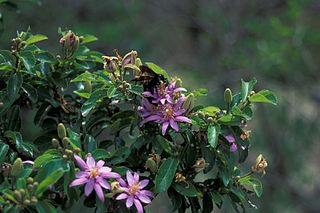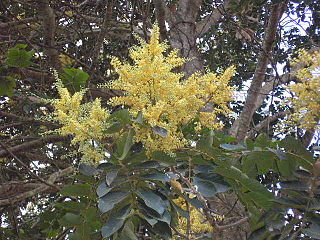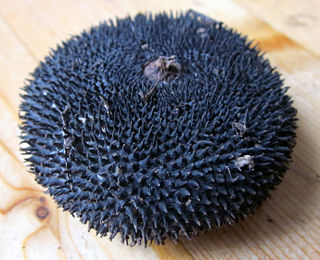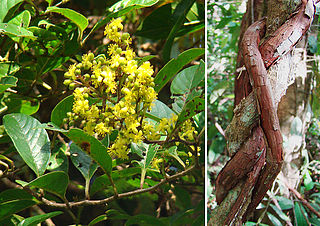
Malvaceae, or the mallows, is a family of flowering plants estimated to contain 244 genera with 4225 known species. Well-known members of economic importance include okra, cotton, cacao and durian. There are also some genera containing familiar ornamentals, such as Alcea (hollyhock), Malva (mallow), and Tilia. The largest genera in terms of number of species include Hibiscus, Sterculia, Dombeya, Pavonia and Sida.

Bombacaceae were long recognised as a family of flowering plants or Angiospermae. The family name was based on the type genus Bombax. As is true for many botanical names, circumscription and status of the taxon has varied with taxonomic point of view, and currently the preference is to transfer most of the erstwhile family Bombacaceae to the subfamily Bombacoideae within the family Malvaceae in the order Malvales. The rest of the family were transferred to other taxa, notably the new family Durionaceae. Irrespective of current taxonomic status, many of the species originally included in the Bombacaceae are of considerable ecological, historical, horticultural, and economic importance, such as balsa, kapok, baobab and durian.

Gentianaceae is a family of flowering plants of 103 genera and about 1600 species.

Hevea is a genus of flowering plants in the spurge family, Euphorbiaceae, with about ten members. It is also one of many names used commercially for the wood of the most economically important rubber tree, H. brasiliensis. The genus is native to tropical South America but is widely cultivated in other tropical countries and naturalized in several of them. It was first described in 1775.

Dipteryx is a genus containing a number of species of large trees and possibly shrubs. It belongs to the "papilionoid" subfamily – Faboideae – of the family Fabaceae. This genus is native to South and Central America and the Caribbean. Formerly, the related genus Taralea was included in Dipteryx.

Parkia is a genus of flowering plants in the family Fabaceae. It belongs to the mimosoid clade of the subfamily Caesalpinioideae. Several species are known as African locust bean.

Grewioideae is a subfamily of the family Malvaceae and was first described by Hochreutiner. The group is named after its type genus, Grewia, which is named for the English scientist Nehemiah Grew (1641-1712). It contains a number of genera that were previously placed in the defunct family Tiliaceae.

Grewia is a large flowering plant genus in the mallow family Malvaceae, in the expanded sense as proposed by the Angiosperm Phylogeny Group. Formerly, Grewia was placed in either the family Tiliaceae or the Sparrmanniaceae. However, these were both not monophyletic with respect to other Malvales - as already indicated by the uncertainties surrounding placement of Grewia and similar genera - and have thus been merged into the Malvaceae. Together with the bulk of the former Sparrmanniaceae, Grewia is in the subfamily Grewioideae and therein the tribe Grewieae, of which it is the type genus.

Andira is a genus of flowering plants in the legume family, Fabaceae. It is distributed in the tropical Americas, except for A. inermis, which also occurs in Africa. It was formerly assigned to the tribe Dalbergieae, but molecular phylogenetic studies in 2012 and 2013 placed it in a unique clade within subfamily Faboideae named the Andira clade.

Macrolobium is a legume genus in the subfamily Detarioideae. It is a tropical genus with about 80 species. Half occur in Brazil, where they are common in the floodplains of the Amazonian Basin. Members of the genus are used as ornamentals and for their wood.

Tachigali is a flowering plant genus in the legume family (Fabaceae). It contains about 75 species.

Apeiba is a genus of shrubs or trees in the family Malvaceae. It is native to tropical America.
Mollia glabrescens is a species of flowering plant in the family Malvaceae sensu lato or Tiliaceae or Sparrmanniaceae. It is found only in Guyana.

Luehea is a genus of trees in the family Malvaceae.
Retiniphyllum is a genus of flowering plants in the family Rubiaceae and contains 20 species. It is the only genus in the tribe Retiniphylleae. The representatives are shrubs or small trees that grow in white sand soils in tropical South America. They are mainly distributed in the Guayana Region (Venezuela) but also occur in the Amazon Basin, the eastern Andes and central and eastern Brasil.

Ferdinandusa is a genus of flowering plants in the family Rubiaceae, native to the American tropics.
Walteranthus is a monotypic genus of flowering plants belonging to the family Gyrostemonaceae. It only contains one known species, Walteranthus erectus.
Lueheopsis is a genus of flowering plants belonging to the family Malvaceae. It is also in the subfamily of Grewioideae.

Davilla is a genus of flowering plants belonging to the family Dilleniaceae. It has around 30 neotropical, species and is one of most diverse genera of lianas, vines, erect or scandent (climbing) shrubs.
Goethalsia is a monotypic genus of flowering plants belonging to the family Malvaceae. It only contains one species, Goethalsia meiantha(Donn.Sm.) Burret It is within the Grewioideae tribe.














